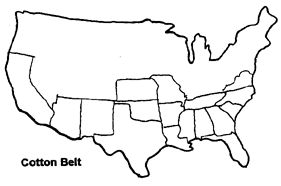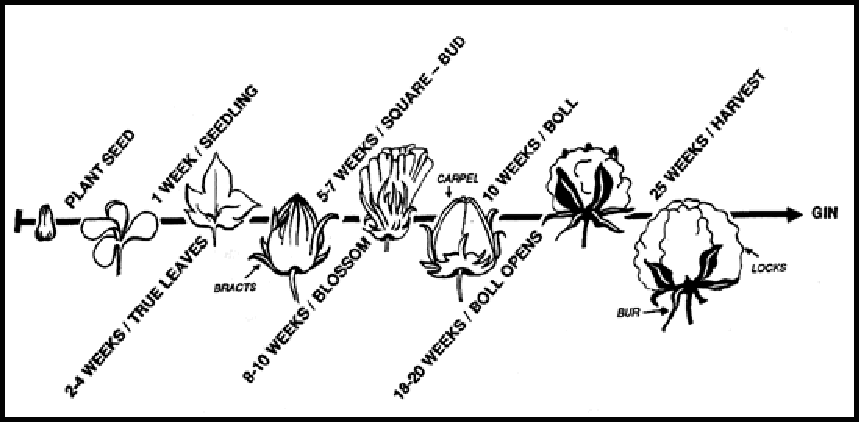The Story of Cotton – The Plant
There are several species of “wild cotton” (cotton that grows uncultivated ) in the world. They have been found in Australia, Africa, Arizona, Central America, Lower California, Brazil, Mexico and other tropical countries and islands. Because of problems related to their refinement, they are not economically feasible to use. Through genetic assistance and breeding, today’s cottons have evolved from these “wild” sources and are more processing friendly.
Currently, there are five prominent types of cotton being grown commercially around the world. They are Egyptian, Sea Island, American Pima, Asiatic and Upland. Because of their need for a long, sunny growing period with at least 160 frost free days they are grown between latitudes 45 degrees north and 30 degrees south. The major producing countries within this region are the United States, Peoples Republic of China, India, Pakistan and Republic of Uzbekistan. Also, Brazil, Australia, Egypt, Argentina, Turkey, Greece, Syria and others produce significant, but lesser amount
 In the U.S. there are fourteen major cotton growing states that produce Upland cotton. They are Alabama, Arizona, Arkansas, California, Georgia, Louisiana, Mississippi, Missouri, North Carolina, Oklahoma, South Carolina, Tennessee, Texas and Virginia. Some cotton is also grown in Florida, Kansas and New Mexico. American Pima cotton is grown in Arizona, California, New Mexico and Texas. All of these states form a region in the United States known as the Cotton Belt and have three things in common, lots of sunshine, water and fertile soil, very important to growing a good cotton crop.
In the U.S. there are fourteen major cotton growing states that produce Upland cotton. They are Alabama, Arizona, Arkansas, California, Georgia, Louisiana, Mississippi, Missouri, North Carolina, Oklahoma, South Carolina, Tennessee, Texas and Virginia. Some cotton is also grown in Florida, Kansas and New Mexico. American Pima cotton is grown in Arizona, California, New Mexico and Texas. All of these states form a region in the United States known as the Cotton Belt and have three things in common, lots of sunshine, water and fertile soil, very important to growing a good cotton crop.
Upland cotton being the most common type in the U.S. has a staple length (length of fiber) of 13/16 to 1 ¼ inches. The American Pima has a staple length of 1 5/16 to 1 ½ inches. These plant types grow and mature at different rates and lengths of time, but basically mature within a 30 day period of each other.
Cotton plants have a general time frame in which they grow and produce after planting (introducing the seed to moist soil). With ideal conditions, the planted cotton seed will germinate (to begin to grow) or sprout and emerge in about five to ten days. The first 2 leaves that are visible on the young cotton plant are seedling leaves called cotyledons (cot-a-lee-dons). They are useful for absorbing sunlight into the plant. The sunlight is then converted through a process known as photosynthesis, into nourishing carbohydrates that will help the plant grow.

In about two to four weeks they turn over the photosynthetic task to true leaves (leaves produced subsequent to the cotyledons) which continue the feeding process for the duration of the plants life. The plant continues to grow, adding leaves and height, and in approximately five to seven weeks, small flower buds called squares (a small flower bud covered with fringed leaf-like parts called bracts) will appear on the cotton plant. As this square develops, the bud swells and begins to push through the bracts until it opens into an attractive flower. Within three days, the flower will pollinate (the transfer of pollen from the anther to the stigma of the same or another flower) itself, change from a creamy white or yellow color to a pinkish red, and then wither and fall, exposing a small, green, immature cotton boll (a segmented pod containing 32 immature seeds from which the cotton fibers will grow). This boll is considered a fruit because it contains seeds. As the fibers continue to grow and thicken within the segmented boll, it enlarges until it becomes approximately the size of a small fig. Now, the cotton fibers have become mature and thickened with their primary growth substance, cellulose (a carbohydrate, the chief component of the cell wall in most plants). An average boll will contain nearly 500,000 fibers of cotton and each plant may bear up to 100 bolls
In about 140 days after planting or 45 days after bolls appear, the cotton boll will begin to naturally split open along the bolls segments or carpels and dry out, exposing the underlying cotton segments called locks. These dried carpels are known as the bur, and it’s the bur that will hold the locks of cotton in place when fully dried and fluffed, ready for picking.
The growth cycle of the various cotton species vary in length, but the sequence of fruit production remain the same. Weather, insects and moisture can adversely affect optimum conditions for plant growth and it is the farmer’s responsibility to adjust to these conditions to optimize yield.
 We have done all the research for you…gathered supplemental literature books, videos and CD’s, and offer a variety of resources to be used in conjunction with your study unit. So let’s get started on our cotton’s journey and learn more about this useful, resourceful and magical plant we take for granted…COTTON!
We have done all the research for you…gathered supplemental literature books, videos and CD’s, and offer a variety of resources to be used in conjunction with your study unit. So let’s get started on our cotton’s journey and learn more about this useful, resourceful and magical plant we take for granted…COTTON! ![]()

